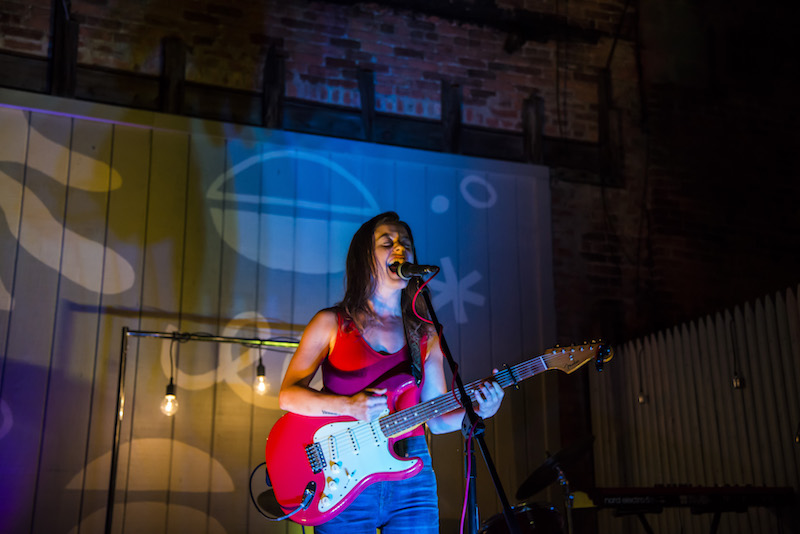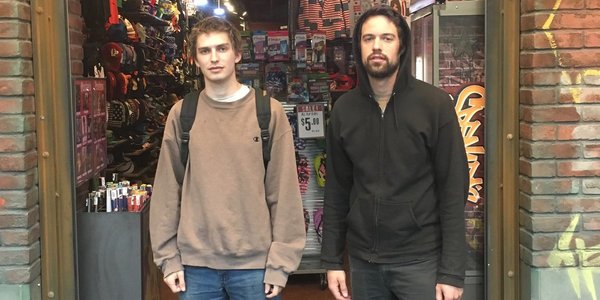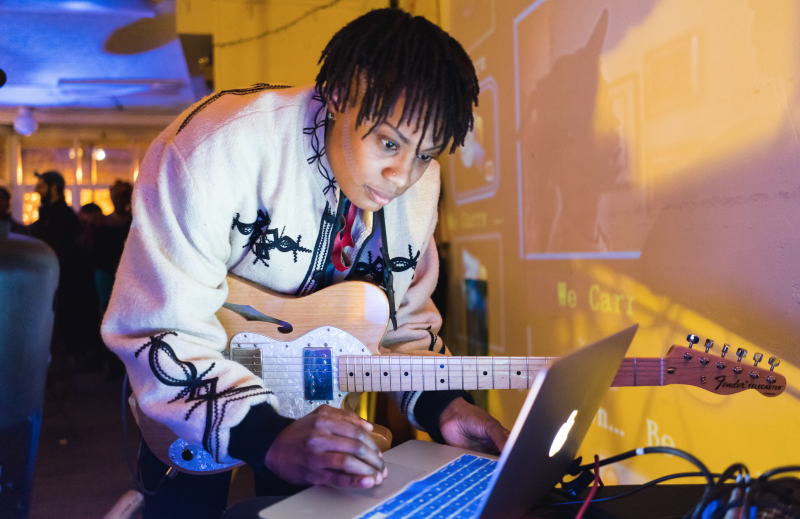Art: Cara Hanley
There is a running trope that for an artist to be truly great, for their work to be profound (to be considered an artist, even) they must be inherently “tortured” and “starving.”
That mentality is incredibly dangerous for those who feel the need to create. It casts darkness over their work and sense of identity, as if the only way they can create is if they are at their worst. In reality, it’s not that artists are inherently “tortured” but that they have chosen to be fully vulnerable by turning their emotions, trauma and personal history into tangible works of art.
When it comes to making art and managing mental health, everyone has a different journey. A few local artists recently spoke to The Collaborative about their own challenges and the coping mechanisms they use to get by and continue creating.
“There’s not a lot of middle ground in this society, for artists,” Troy singer-songwriter Olivia Quillio says. “So much of the art lifestyle that’s commercialized, as well as glamorized, is as a vagabond. But you have to give yourself a home because you need a place to truly rest. A lot of artists are traumatized people.”
When beginning to address mental health, take a moment to accept who you are and what you’re capable of doing. Identifying oneself as an artist in the first place—and not one who has to suffer to create—can be a difficult starting point.
“I’m now at the stage in my life where I’m accepting that I’m an artist. This is the way my brain works. I wanted to have this great writing and be able to do a 9-to-5—and I did do it, but it put me into such a low place, mentally. I had to figure out what the ground even was for me before I could find a ‘middle ground,’” Quillio says.

SETTING BOUNDARIES
“Boundaries are limits we place for ourselves to protect ourselves,” Charis Thompson, a mental health counselor at Northern Rivers – Northeast in Schenectady says. “Boundaries can be about our time, space, money, bodies or conversations. We live in a culture that wants instant gratification and doesn’t always value art or creativity. So, for artists, it would be extra important to have clear boundaries.”
While it can be difficult to separate what you want to accomplish as an artist vs. what you are able to accomplish in a healthy way, setting boundaries for yourself and the people you do business with is a great way to start.
Thompson lays out a set of examples that include:
– What time frame is reasonable for you and your life?
– What price do you need to charge to honor your time and training, as well as care for yourself?
– What work are you willing to do? If you are doing work for “exposure,” it should be trading the actual value of your work for an actual value of marketing (and expected profit down the line) that will receive.
Musicians’ personal boundaries are challenged when separating oneself in their day-to-day life with the person who performs (i.e. the personality audiences expect from a performer). Presenting difficult material and then sticking around to shake hands and chat, particularly with audience members who want to share their own experiences, can be as mentally exhausting as it can be gratifying.
“I’ve been really open with my troubles and I’ve had people come up to me after shows and tell me how and why they relate and that’s really fulfilling,” Caitlin Barker of Troy band Candy Ambulance explains.
“Art comes from feeling things. The artist takes the feeling and examines it. Shines light in every corner. It’s heavy work.”
“I think allowing yourself to feel that much can be confusing, especially if you then take that work and ask the world to take a look or listen. I make money off this song about my abusive ex or my drinking problems. Do I need to keep them present? Will a healthy me be unable to create? My answer to myself is that therapy has been immensely helpful and I’ll probably go forever but the thoughts, they creep.”
There is also a unique boundary challenging aspect to the touring lifestyle. Albany drummer Jevan Dollard (Jouska, Leering, Geoff Gordon, Greens) says he’s had to get particularly creative with his coping mechanisms when living on the road.
“I’ll do something pretty much every day when I’m home that mixes things up. A new coffee shop, taking a little trip, a phone call to a friend I haven’t talked to in a while, hanging out with people I don’t usually spend time with. You don’t really have access to that on the road.”
Dollard says it’s important to realize, particularly for introverts, when you are beginning to withdraw under stress. Identify your own patterns, take a step back and be open to moments of spontaneity, when you are ready to let your guard down.
CREATING, MAINTAINING AND TAKING PART IN COMMUNITY
“Humans aren’t made to function independently,” Thompson says. “We need support, encouragement and connection. The creative process can be a solitary experience. Network, connect with other artists, get support, build relationships, find inspiration from what others are doing.”
The face-to-face connection is something artists rely on—the steady feedback and real, human support. Dollard and Quillio both expressed their struggles with losing that connection to social media.
“When you’re booking a tour and planning it out, everything you are doing is through social media. That means you’re updating Bands In Town or trying to track down friends in each city, making sure people spread the word, and that can turn into four or five hours on social media in a day. That only adds to the already monotonous routine of tour,” Dollard says.
He also says a big challenge of touring and working as a musician is relying on, and working within, community—whether that be the scene at large or the band he is playing with.
“There’s very little face-to-face interaction or there’s a different type of it,” he says. “You’re with the same three people in a van for five weeks and you’re sick of each other or you’re meeting people on the road who come off as extremely nice but wind up being dangerous, toxic or you don’t know what you’re getting into. There isn’t the security of community.”
Sometimes one’s mood can be entirely reliant on the relationship of the band. Dollard recalls one tour with Jouska when the band drove from Buffalo to Pittsburgh only to find the venue closed and the booking contact MIA. The show had been cancelled without their knowledge, they had four days off and couldn’t find anyone in town. They ended up camping in the deep woods—a difficult spot to find, which made things tense in the van. No one could shake the bad mood until bandmate John Mongonia suggested they all “take a silent moment of meditation by themselves.”
With some quiet time, they came back together and singer Doug Dulgarian was able to feel comfortable and vulnerable enough with the band to share a new song he was writing, “Swill.” They spent the rest of the night working on their own parts and the song became the epic closing track of their 2018 EP From Elson to Emmett.
“Moods are contagious,” he says. “It’s important to use the power of intent, take responsibility for how you’re feeling and to identify that you are all dependent on each other.”
He adds it was also nice to have at least one person in the group who was able to steer them in positive ways.

But not everyone has a built-in sense of community.
Quillio says cooking has become her new favorite coping mechanism when it comes to resolidifying her sense of community. She recently made soup to share with her neighbors and has thought about starting a weekly artist potluck to encourage consistent presence around each other that she hopes more open and honest communication and inspiration.
“We all just have to really start being with each other, it’s nerve wracking,” Quillio says. “It’s like we’re breaking this bubble. With these past five or six years on Instagram, like, we’re all on this hyper-sensitive, conscious paranoia or panic. I’m starting a band again and it’s terrifying. It’s very uncomfortable. Because I’m leaning in. I’m allowing other people in and I’m trusting.”
“We can all be our own harshest critics,” Thompson says. “Give yourself grace and be patient with yourself. Life is not a destination, it is a journey and a process. Creating takes time, building a business takes time, gaining confidence and stability takes time.”
TAKE TIME TO IDENTIFY & DISMANTLE PRESSURE AND SELF-CRITICISM
With plenty of solitary time spent creating (and overthinking), artists deal with heightened senses of inadequacy, experiencing bouts of self-doubt and imposter syndrome.
“I hadn’t heard of imposter syndrome and when I looked it up, my mind went to live shows and how when I’m playing them I think it’s pure shit,” Barker says. “Then I see a video and I breathe relief knowing I wasn’t fucking up the whole time. Confidence is challenging and my only weapon against it is practice.”
“As a band, Candy Ambulance has experienced mass ego death about what our expectations are versus reality,” she continues. “It used to weigh me down and I’d measure myself by other bands, like ‘How have we been grinding for 5 years and only have like 200 Spotify listeners a month?’ It’s a yucky rabbit hole.”
KNOW YOUR LIMITS & DON’T HESITATE TO FIND HELP WHERE YOU CAN
“I go to therapy pretty regularly and even if it doesn’t move mountains for me every time, it always helps,” Barker says. “Alcohol is faster and cheaper and suits the lifestyle so that’s always something I’ve feared about future success. Where do I end up on this trajectory?”
She adds that practicing yoga (Bryan Kest Power Yoga and Yoga with Adrienne for free on YouTube), cooking, cleaning and practicing other bands’ songs to push past creative blocks have helped her recenter.
“Known your limits when it comes to how much stimulation you can handle,” Dollard says. “It can be difficult finding the will to be creative when we’re in these situations. We’re inspired by weird things—some people are inspired by their depression, some people are not. Sometimes when you’re feeling a certain way, that state of mind will keep you from your creative things. Hitting that reset button once in a while can help.”
“Find a therapist, ask about a sliding scale if the price isn’t feasible or find a support group (which are usually more moderately priced or sometimes free). You don’t have to do this alone,” Thompson says, adding that her own agency, Northern Rivers, offers a sliding scale for people who don’t have insurance and won’t turn anyone away.
Thompson also suggests Root3d in Albany, particularly for people of color looking for a safe space. The healing arts center offers a variety of group meetings and one-on-one sessions (Reiki, Intuitive readings, energy healing) as well as therapeutic yoga, writing, dance and theatre classes, often on a sliding scale.
The financial burden of being an artist is a heavy one. A recent survey taken by The Collaborative found that from about 250 local musicians, 12 percent responded that they did not have any health insurance. Another 31 percent of artists skipped the question altogether. Artists need help wherever they can find it.
While locally, we have annual festivals like O+ in Kingston—and as of 2019, North Adams, Mass.—there is a need for a reliable network for artists to get care. Quillio points out the Health Alliance for Austin Musicians (HAAM), providing access to affordable healthcare for Austin’s low-income working musicians, which she was able to take advantage of while living there. It’s something she’d like to see pop up in this area as well, if not the entire country.
“They understand that this is not a game. You’re here to make music, so you get this privilege and it’s funded by a bunch of benefactors that are wildly wealthy. It was kind of like the land of the free because people give a shit. That is the corner that we’re being backed into here.”
Art is an exchange and community support makes a huge difference in the life of an artist.

“There’s been so much kindness,” Barker says. “Our fans support us so much on the road. It’s so common to be treated to nourishing meals and quiet spaces to rest on tour. Friendships and sharing with other artists—I cherish those connections. Sitting and smoking on a porch in Chicago. Festivals like Mile of Music and O+ Fest provide healthcare services, dental work and high quality earplugs. I apparently had a fungal infection my whole life and a dermatologist at Mile of Music diagnosed it and I don’t have it anymore because she told me how to treat it! I never gave it any priority [before] because it wasn’t painful and because of money.”
“We are moving emotional and physical materials and transmitting energy all the time,” Quillio adds. “When you go to a show and you feel different afterwards, it’s because of that energy work.”
For a full directory of support groups, visit the Mental Health Association of New York State or Open Path Collective for a network of affordable mental health care options.




